I haven't updated this in a while because I haven't made any progress. It's been too cold to paint outside, and I have some other things to seriously reconsider. Not everything is working out the way I plan. I still fully intend to finish this build, but the final product may be a little different from my vision. Oh well, sometimes we have to make adjustments.
This is mainly a test post; I'm trying to figure out how I can make the layout better on my music blog. The rest of the text is BS for layout testing purposes.
Saurian333's B(uild)log
Sunday, January 30, 2011
Monday, August 30, 2010
Plasma
I made some progress on the shell yesterday, but I'll post pics when I'm a little further along. For now, though...the plasma ball arrived today! So, I got to work on that immediately.
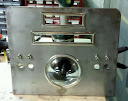
There's a gap in the molding at the bottom, but I'd planned on covering the seam with something anyway. Not sure what yet; I'll know it when I see it, I guess. I think it turned out pretty well. It kind of amazes me how much this thing is starting to look like my model. Just goes to show how a carefully planned project turns out better for me than my usual approach (making it up as I go based on a loose idea).
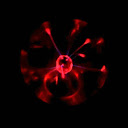
A fun shot of the ball in the dark, manipulated a bit. It actually looks even cooler than that. ;-)
I decided to stick Gnome on this machine instead of KDE; the latter is just too much of a hog, and buggier than the last time I used it. Gnome will work better as I try to get some games working in Wine. Guild Wars installed flawlessly using PlayOnLinux, and seems to be working upon initial tests. The only thing I miss is that in KDE, my editor stays in the foreground when I right-click a Picasa photo for the link, and now I have to switch back and forth again. Oh well, what's a little more clicking per post, other than carpal tunnel?

There's a gap in the molding at the bottom, but I'd planned on covering the seam with something anyway. Not sure what yet; I'll know it when I see it, I guess. I think it turned out pretty well. It kind of amazes me how much this thing is starting to look like my model. Just goes to show how a carefully planned project turns out better for me than my usual approach (making it up as I go based on a loose idea).

A fun shot of the ball in the dark, manipulated a bit. It actually looks even cooler than that. ;-)
I decided to stick Gnome on this machine instead of KDE; the latter is just too much of a hog, and buggier than the last time I used it. Gnome will work better as I try to get some games working in Wine. Guild Wars installed flawlessly using PlayOnLinux, and seems to be working upon initial tests. The only thing I miss is that in KDE, my editor stays in the foreground when I right-click a Picasa photo for the link, and now I have to switch back and forth again. Oh well, what's a little more clicking per post, other than carpal tunnel?
Sunday, August 29, 2010
Front panel
Finally got my shit together and posted pics. Also finally got some work done. :-P
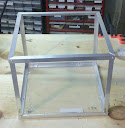
The finished frame I forgot to take a picture of. I think if I did this again I'd use 3/4" angle after all, because this one is a touch flimsy, but it should be sturdy enough once I install the drive mounts and such.

For the front panel, I took a side panel from that old case I posted pics of in the beginning and laid out my piece. I used the existing bottom edge of the panel for the bottom edge of my front, and drew the piece with about 1/2" of space to fold the other edges back,


Then I cut it out with the nibbler and folded the edges under. Nibbling took a long time and a fair bit of sweat. The folds aren't perfect, but they're acceptable; best I could do without a bending brake. I will definitely be getting a brake if I do another project like this, though.
I figured some rough sizes for the VFD and DVD openings, then added to them the thickness of the chrome molding. I laid these out sometime during the week, after work one night. On Friday, I cut those out with the nibbler. Later, I went out and picked up a switch (just one for now, to get measurements) and some LED holders, and drilled out their locations. The only thing left to mark off is the plasma ball, and I don't have that to measure yet. So, I moved onto the sanding.


Saturday: I tried several different sanding methods to no avail. Hand sanding got some metal exposed, but even applying heat beforehand, it was way too much work. The palm sander just made paint dust and never actually took it off. I was about to give up and paint the fucking thing, when I remembered my detail sander. I gave it a shot, and it was working! The extra-coarse sheet is what did the trick, I think; I only had one of those, so I was lucky to make it through before it wore out.
Unfortunately, my bending and cutting left a couple of small divots in the front face, and I knew I'd never get those sanded evenly. Oh well; most of it is at the edges, so it shouldn't be too visible once the whole thing is together. The other spots will hopefully just make it look a little used/aged.
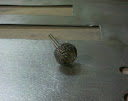
To get the remaining paint out of the deeper spots, I used a Dremel wire wheel. Rather than get out the Dremel, I popped it in my drill, and it worked very well, but this is what it looked like when I was done. Glad I have more of those!
After that, I block sanded it with 100-grit to get the grain looking right, and went over it again with a wire brush. I polished it a bit with some rubbing compound, and the end result is pretty decent. You'll see that in the next pics, although it needed to be cleaned up again by then. It should look pretty good when I'm ready to assemble.
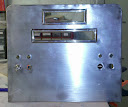

The chrome molding went on next. It didn't turn out as well as I'd hoped. I might try something else, or at least come up with something to cover the corner seams. That molding is a modder's friend for covering roughly cut edges: it's flexible, self-adhesive, and cheap. However, it doesn't do well on 90-degree corners, and always leaves the seams to deal with. It's perfect for a blowhole, though, especially if you're putting a gril over the top of it (one of the screwhole legs will cover the seam nicely). Next were the LED holders, which I ended up liking even better than my original lamp lens idea; they really look like they belong there, I think. I added the one switch I bought for the pictures. In the closeup of the LED holders, you can see the grain on the stainless a little better, too.
Today, I'm either going to work on the drive mounts or the outer shell. Probably the shell, so I can get to painting before the warm weather is over.

The finished frame I forgot to take a picture of. I think if I did this again I'd use 3/4" angle after all, because this one is a touch flimsy, but it should be sturdy enough once I install the drive mounts and such.

For the front panel, I took a side panel from that old case I posted pics of in the beginning and laid out my piece. I used the existing bottom edge of the panel for the bottom edge of my front, and drew the piece with about 1/2" of space to fold the other edges back,


Then I cut it out with the nibbler and folded the edges under. Nibbling took a long time and a fair bit of sweat. The folds aren't perfect, but they're acceptable; best I could do without a bending brake. I will definitely be getting a brake if I do another project like this, though.
I figured some rough sizes for the VFD and DVD openings, then added to them the thickness of the chrome molding. I laid these out sometime during the week, after work one night. On Friday, I cut those out with the nibbler. Later, I went out and picked up a switch (just one for now, to get measurements) and some LED holders, and drilled out their locations. The only thing left to mark off is the plasma ball, and I don't have that to measure yet. So, I moved onto the sanding.


Saturday: I tried several different sanding methods to no avail. Hand sanding got some metal exposed, but even applying heat beforehand, it was way too much work. The palm sander just made paint dust and never actually took it off. I was about to give up and paint the fucking thing, when I remembered my detail sander. I gave it a shot, and it was working! The extra-coarse sheet is what did the trick, I think; I only had one of those, so I was lucky to make it through before it wore out.
Unfortunately, my bending and cutting left a couple of small divots in the front face, and I knew I'd never get those sanded evenly. Oh well; most of it is at the edges, so it shouldn't be too visible once the whole thing is together. The other spots will hopefully just make it look a little used/aged.

To get the remaining paint out of the deeper spots, I used a Dremel wire wheel. Rather than get out the Dremel, I popped it in my drill, and it worked very well, but this is what it looked like when I was done. Glad I have more of those!
After that, I block sanded it with 100-grit to get the grain looking right, and went over it again with a wire brush. I polished it a bit with some rubbing compound, and the end result is pretty decent. You'll see that in the next pics, although it needed to be cleaned up again by then. It should look pretty good when I'm ready to assemble.


The chrome molding went on next. It didn't turn out as well as I'd hoped. I might try something else, or at least come up with something to cover the corner seams. That molding is a modder's friend for covering roughly cut edges: it's flexible, self-adhesive, and cheap. However, it doesn't do well on 90-degree corners, and always leaves the seams to deal with. It's perfect for a blowhole, though, especially if you're putting a gril over the top of it (one of the screwhole legs will cover the seam nicely). Next were the LED holders, which I ended up liking even better than my original lamp lens idea; they really look like they belong there, I think. I added the one switch I bought for the pictures. In the closeup of the LED holders, you can see the grain on the stainless a little better, too.
Today, I'm either going to work on the drive mounts or the outer shell. Probably the shell, so I can get to painting before the warm weather is over.
Labels:
lots and lots of sanding,
modding,
PC build,
project
Friday, August 27, 2010
Getting down to it
I hope to get a lot done this weekend. Pics of the most recent work will be posted later today (front panel has been cut out and is marked for cutting holes), and the most recent render is in the pane on the right.
Since I soon have to disassemble the PC for test-fitting into the mod, that's probably going to be the last render. I'll be setting up the old PC again so I can continue to browse and post while I'm working, but it just doesn't have enough power to render the model in it's current state anymore (unless I let it run all freaking day). I think I've got it where I want it now. The VFD got moved to the top so the DVD and HDDs can be mounted together and in the right place (also helps airflow to the blowhole), and the ball got moved up a bit so it clears the motherboard components (don't know what happened in the render with that steel face inside the ball at the top; I can't find it in the model). Fixed the USB ports which I noticed weren't showing up for a while. I'm not entirely sure about the mounting of the USB ports yet; I might use some kind of chrome faceplate or something.
Here's today's optimistic to-do list:
1a) get some 3/4" angle again, to use for drive mounting and such
1b) assemble drive mounts into frame
2) start cutting on front panel (finish when plasma ball arrives; need exact diameter before cutting hole)
3) start sanding/bending/cutting on the outer shell so I can paint it soon.
4) test the PAE-SATA adapter before tearing PC down (it arrived yesterday)
Since I soon have to disassemble the PC for test-fitting into the mod, that's probably going to be the last render. I'll be setting up the old PC again so I can continue to browse and post while I'm working, but it just doesn't have enough power to render the model in it's current state anymore (unless I let it run all freaking day). I think I've got it where I want it now. The VFD got moved to the top so the DVD and HDDs can be mounted together and in the right place (also helps airflow to the blowhole), and the ball got moved up a bit so it clears the motherboard components (don't know what happened in the render with that steel face inside the ball at the top; I can't find it in the model). Fixed the USB ports which I noticed weren't showing up for a while. I'm not entirely sure about the mounting of the USB ports yet; I might use some kind of chrome faceplate or something.
Here's today's optimistic to-do list:
1a) get some 3/4" angle again, to use for drive mounting and such
1b) assemble drive mounts into frame
2) start cutting on front panel (finish when plasma ball arrives; need exact diameter before cutting hole)
3) start sanding/bending/cutting on the outer shell so I can paint it soon.
4) test the PAE-SATA adapter before tearing PC down (it arrived yesterday)
Sunday, August 22, 2010
Assembling the frame
Here's what got done last night.

I fit the pieces together and broke out a piece of plexi for the bottom. This was a quick test fit to check my measurements. Note that it just fits within the frame...
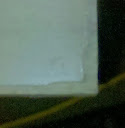
...so I had to notch out the corners to leave room for the vertical pieces to fit. Nothing fancy, just took the Dremel (generic rotary tool, actually) with a grinding drum to it. Sorry for the crappy pic, but you can see what I did.
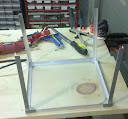
Duct tape is a wonderful thing. Here you can see the bottom taped together (it will be riveted in the end) with the plexi sitting in place and the vertical pieces...
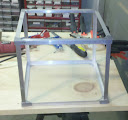
...and the same with the top frame taped together. Looking good so far. With all the test-fitting done, it was time to rivet the plexi to the bottom.
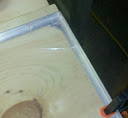
You have to be careful working with plexi. You can take all the precautions in the world, but your drill bit can still pull it up and crack it. I was almost done drilling when this happened, right next to a clamp (removed that one before taking the pic). After a smoke break to consider my course of action, I decided that even though this wouldn't be seen, it would bug the hell out of me if I didn't replace it, considering I have plenty more plexi lying around. Also, I'd never forgive myself if it cracked the rest of the way through.

Having decided, here is the new piece, safely drilled and riveted in place.
Right now, I'm working on drilling out the vertical pieces and will rivet the whole frame together. I thought of taking pics of the process, but it's very tedious and boring. Basically, it involves drilling the top/bottom corners, fitting the vertical piece into the appropriate corner to mark the hole, then drilling the vertical. I tried clamping it down to drill through all at once, but it wasn't going so well; this is longer, but easier. I'll post one pic when it's all together and I'm ready to move on to something else.

I fit the pieces together and broke out a piece of plexi for the bottom. This was a quick test fit to check my measurements. Note that it just fits within the frame...

...so I had to notch out the corners to leave room for the vertical pieces to fit. Nothing fancy, just took the Dremel (generic rotary tool, actually) with a grinding drum to it. Sorry for the crappy pic, but you can see what I did.

Duct tape is a wonderful thing. Here you can see the bottom taped together (it will be riveted in the end) with the plexi sitting in place and the vertical pieces...

...and the same with the top frame taped together. Looking good so far. With all the test-fitting done, it was time to rivet the plexi to the bottom.

You have to be careful working with plexi. You can take all the precautions in the world, but your drill bit can still pull it up and crack it. I was almost done drilling when this happened, right next to a clamp (removed that one before taking the pic). After a smoke break to consider my course of action, I decided that even though this wouldn't be seen, it would bug the hell out of me if I didn't replace it, considering I have plenty more plexi lying around. Also, I'd never forgive myself if it cracked the rest of the way through.

Having decided, here is the new piece, safely drilled and riveted in place.
Right now, I'm working on drilling out the vertical pieces and will rivet the whole frame together. I thought of taking pics of the process, but it's very tedious and boring. Basically, it involves drilling the top/bottom corners, fitting the vertical piece into the appropriate corner to mark the hole, then drilling the vertical. I tried clamping it down to drill through all at once, but it wasn't going so well; this is longer, but easier. I'll post one pic when it's all together and I'm ready to move on to something else.
Plexi tips
In a futile attempt to find some kind of mesh that wasn't outrageously expensive, I decided to skip it. It's really not necessary, and it would have required the motherboard mounting tray to be raised above it. I decided just to rivet plexi to the bottom frame, and the board will be mounted directly onto that.
Here's the plexi trick that I learned while building my arcade cab. I've heard many different opinions on the best way to cut/break plexi, and they're all tricky and rarely work for me. So, I came up with my own way. I'm sure I'm not the first, but I haven't seen it elsewhere, so here it is...
 Step 1: Measure and lightly score where your break will be, and line up that score line with the edge of your workbench (or a good, straight board edge). Place a board on top, also lined up with the score line. Clamp it down tight. It's best to have the scrap end outside, so that your desired piece is protected. When you break, if it happens to stray from your score lines, it will happen outside the edge of the board.
Step 1: Measure and lightly score where your break will be, and line up that score line with the edge of your workbench (or a good, straight board edge). Place a board on top, also lined up with the score line. Clamp it down tight. It's best to have the scrap end outside, so that your desired piece is protected. When you break, if it happens to stray from your score lines, it will happen outside the edge of the board.
 Step 2: Score deeply along that line. I got this handy little tool for it, but a sharp razor blade works just as well. Make sure it goes quite deep, and that you go all the way to the edges of your piece. If you skimp at the edges, you'll have some filing/Dremel-ing to do, and unless you're really good, it will probably never be quite even.
Step 2: Score deeply along that line. I got this handy little tool for it, but a sharp razor blade works just as well. Make sure it goes quite deep, and that you go all the way to the edges of your piece. If you skimp at the edges, you'll have some filing/Dremel-ing to do, and unless you're really good, it will probably never be quite even.
 Step 3: You only see one of my hands here, but you'll want to use both hands. Place your hands in positions at which the pressure will be evenly distributed along the break line. I find it easiest to have the heels of my hands closer to the score lines, with my fingers curling under the edge of the piece. Now, start to apply pressure, then push down sharply. I wore the gloves here to get a good grip, since I was breaking off a pretty small piece.
Step 3: You only see one of my hands here, but you'll want to use both hands. Place your hands in positions at which the pressure will be evenly distributed along the break line. I find it easiest to have the heels of my hands closer to the score lines, with my fingers curling under the edge of the piece. Now, start to apply pressure, then push down sharply. I wore the gloves here to get a good grip, since I was breaking off a pretty small piece.
 You should get a lovely, clean break every time. The key is the board on top applying pressure. I always hear people say you just need to apply even pressure on both sides, but for longer breaks, it will still crack outside your score line. If your piece is about 6" wide or less, you can probably get away without the board and use one hand on each side of the line.
You should get a lovely, clean break every time. The key is the board on top applying pressure. I always hear people say you just need to apply even pressure on both sides, but for longer breaks, it will still crack outside your score line. If your piece is about 6" wide or less, you can probably get away without the board and use one hand on each side of the line.
Here's the plexi trick that I learned while building my arcade cab. I've heard many different opinions on the best way to cut/break plexi, and they're all tricky and rarely work for me. So, I came up with my own way. I'm sure I'm not the first, but I haven't seen it elsewhere, so here it is...
 Step 1: Measure and lightly score where your break will be, and line up that score line with the edge of your workbench (or a good, straight board edge). Place a board on top, also lined up with the score line. Clamp it down tight. It's best to have the scrap end outside, so that your desired piece is protected. When you break, if it happens to stray from your score lines, it will happen outside the edge of the board.
Step 1: Measure and lightly score where your break will be, and line up that score line with the edge of your workbench (or a good, straight board edge). Place a board on top, also lined up with the score line. Clamp it down tight. It's best to have the scrap end outside, so that your desired piece is protected. When you break, if it happens to stray from your score lines, it will happen outside the edge of the board. Step 2: Score deeply along that line. I got this handy little tool for it, but a sharp razor blade works just as well. Make sure it goes quite deep, and that you go all the way to the edges of your piece. If you skimp at the edges, you'll have some filing/Dremel-ing to do, and unless you're really good, it will probably never be quite even.
Step 2: Score deeply along that line. I got this handy little tool for it, but a sharp razor blade works just as well. Make sure it goes quite deep, and that you go all the way to the edges of your piece. If you skimp at the edges, you'll have some filing/Dremel-ing to do, and unless you're really good, it will probably never be quite even. Step 3: You only see one of my hands here, but you'll want to use both hands. Place your hands in positions at which the pressure will be evenly distributed along the break line. I find it easiest to have the heels of my hands closer to the score lines, with my fingers curling under the edge of the piece. Now, start to apply pressure, then push down sharply. I wore the gloves here to get a good grip, since I was breaking off a pretty small piece.
Step 3: You only see one of my hands here, but you'll want to use both hands. Place your hands in positions at which the pressure will be evenly distributed along the break line. I find it easiest to have the heels of my hands closer to the score lines, with my fingers curling under the edge of the piece. Now, start to apply pressure, then push down sharply. I wore the gloves here to get a good grip, since I was breaking off a pretty small piece. You should get a lovely, clean break every time. The key is the board on top applying pressure. I always hear people say you just need to apply even pressure on both sides, but for longer breaks, it will still crack outside your score line. If your piece is about 6" wide or less, you can probably get away without the board and use one hand on each side of the line.
You should get a lovely, clean break every time. The key is the board on top applying pressure. I always hear people say you just need to apply even pressure on both sides, but for longer breaks, it will still crack outside your score line. If your piece is about 6" wide or less, you can probably get away without the board and use one hand on each side of the line.
Saturday, August 21, 2010
D'oh!
That piece of mesh isn't big enough. Could have sworn I had more left than that.
Oh well, I'll find something else.
Oh well, I'll find something else.
Subscribe to:
Posts (Atom)